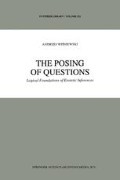Abstract
The aim of this Chapter is to introduce the basic semantic tools which will be used in our further considerations. The semantics which we are going to present is basically a version of model-theoretical semantics; some new concepts are introduced for the purposes of erotetic analysis. The semantic concepts defined below pertain to any of the formalized languages for which we defined in Chapter 3 the concept of question.
Access this chapter
Tax calculation will be finalised at checkout
Purchases are for personal use only
Preview
Unable to display preview. Download preview PDF.
References
Cf., e.g., Wójcicki (1984).
The paper Wiśniewski (1987) is an abstract of the paper presented at the VIII International Congress of Logic, Methodology and Philosophy of Science, Moscow 1987. For some mysterious reasons the organizers retyped the manuscript before printing without making any proof reading. As a result this paper presumably wins the world record for misprints.
Cf. Belnap & Steel (1976), p. 126.
In Belnap’s terminology a prospective presupposition is a d-wff which expresses the presupposition of the question.
Buszkowski, who in fact introduced this concept (cf. Buszkowski, 1989), uses here the term correct question.
The definition proposed above is similar to that given by Popper (cf. Popper, 1959, p. 120), who, however, uses the concept of derivability.
A similar idea was suggested by Belnap (cf. Belnap, 1963, Chapter 7.7, or Belnap & Steel, 1976, p. 73). Belnap, however, does not apply it in his general considerations.
Author information
Authors and Affiliations
Rights and permissions
Copyright information
© 1995 Springer Science+Business Media Dordrecht
About this chapter
Cite this chapter
Wiśniewski, A. (1995). Semantics. In: The Posing of Questions. Synthese Library, vol 252. Springer, Dordrecht. https://doi.org/10.1007/978-94-015-8406-7_4
Download citation
DOI: https://doi.org/10.1007/978-94-015-8406-7_4
Publisher Name: Springer, Dordrecht
Print ISBN: 978-90-481-4595-9
Online ISBN: 978-94-015-8406-7
eBook Packages: Springer Book Archive

